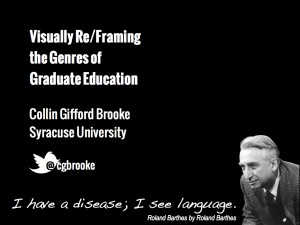I’ve spent the better part of today scribbling in a notebook and mapping out possibilities for the talk that I’ll be giving at the end of the month. The struggle I sometimes run into is that I tend to start in the middle, with a handful of viable theses, which I then proceed to connect up. Then I’ll trace each of them outwards to possible sources, associations, and examples until I have a huge tangled mess of stuff.
Actually, that’s not the struggle. I’ve (always) got plenty of material. The trick is smoothing it out and paring it down until I have something that will legitimately fit into the 15 minutes or so I have. And then adding in more citations and connective tissue and paring it down again. Like everyone else, I’d imagine, I have to find the balance between having enough context and making a point clearly. Pull one string out, and I might make what’s left that much more manageable. I might also cause the whole thing to unravel.
Generally speaking, I work backwards from the first major point that I want to make for my introduction. Almost everything I write tends to work that way–to make point C, first I have to provide context A and transition B. And then I have to provide context Y and transition Z to get to A. And so on. I almost always cut the first 5-6 pages of writing to get myself to a viable first draft for an article or an essay. As soon as I’d worked myself back today to “When I was first hired at Syracuse…” I knew it was time to start cutting. No one is coming to hear me muse on 11 years of personal/institutional history.
My point right now? Thanks for asking. 🙂 It’s that we can use the tools of network visualization to help ourselves acquire what Artemeva and Fox call “disciplinary genre competence.” Direct and to the point, I think. The panel itself is about genre studies and graduate education, so I’ll be talking about some of the viz assignments that I’ve given over the past several years in the courses I’ve taught, and rationalizing them in terms of some genre studies scholarship.
And I have a slide. Lots more to create after this, but usually if I’m feeling good about where to start, I’ll start mixing my inventional platforms. By the end of a talk, I’m usually writing it in Keynote. So this is step 1:
I’ll post more of the talk as it takes shape. My plan is to drop slides, notes, and sources online ahead of the conference…
